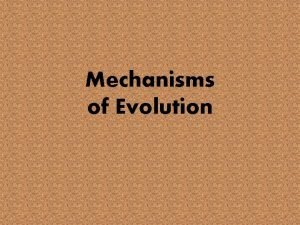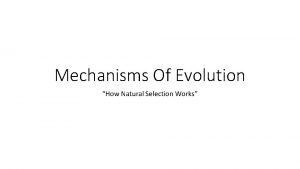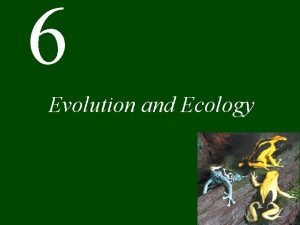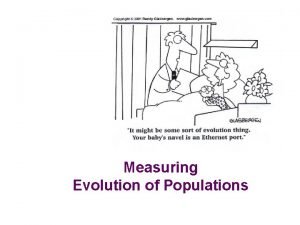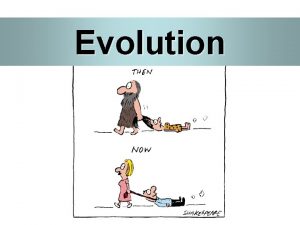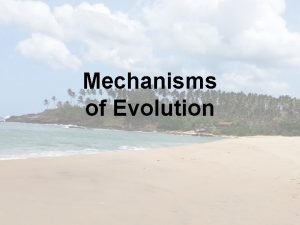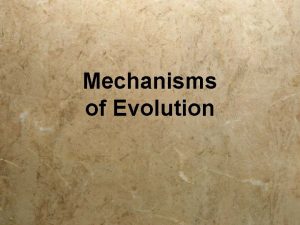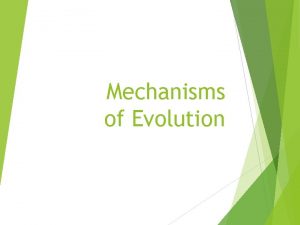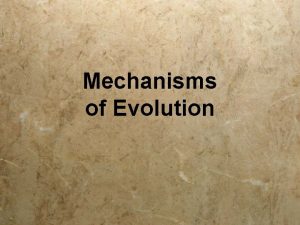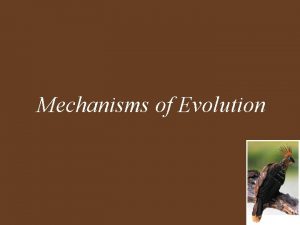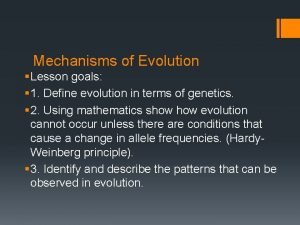Mechanisms of Evolution Goals 1 Understand the four










- Slides: 10

Mechanisms of Evolution

Goal(s): 1) Understand the four mechanisms of evolution, how each causes evolution, how these mechanisms (potentially) interact to produce this change, and why evolution is relevant to me. Outcome(s): 1) Analyze a dataset and propose a mechanism for evolution.


• Peter and Rosemary Grant have been studying finches in the Galapagos Islands since 1973.

Case Study: Geospiza fortis on Daphne Major

Variation in beak depth in Geospiza fortis 1976

Information of Interest 1. Beak size corresponds with a preference for seed size. i. e. large beak depth = large seeds, small beak = small seeds 2. A major drought occurred in 1977. 3. The majority of the seeds pre-drought = medium seeds; post-drought = large seeds

Number of Finches 12 8 4 0 6 7 8 9 10 11 12 13 14 Mean Beak Depth (mm) 2. Number of Finches Which of the following graphs best represents the beak size distribution of the population of adults in 1978 (after the drought)? 1. 44 40 36 32 28 24 20 16 12 8 4 0 6 7 8 9 10 11 12 Mean Beak Depth (mm) 3. Number of Finches Given the information of interest and initial beak depth distribution: 12 8 4 0 6 7 8 9 10 11 12 Mean Beak Depth (mm)

Number of Finches 12 8 4 0 6 7 8 9 10 11 12 13 14 Mean Beak Depth (mm) 2. Number of Finches Which of the following graphs best represents the beak size distribution of the population of adults in 1978 (after the drought)? 1. 44 40 36 32 28 24 20 16 12 8 4 0 6 7 8 9 10 11 12 Mean Beak Depth (mm) 3. Number of Finches Given the information of interest and initial beak depth distribution: 12 8 4 0 6 7 8 9 10 11 12 Mean Beak Depth (mm)

Geospiza fortis: Offspring Given, genetic traits (e. g. , in this case - beak depth) are heritable (i. e. can be passed from generation to generation): (1) describe any observed difference(s) in beak size of chicks born in 1976 versus 1978, and (2) formulate a hypothesis to explain this difference.
 Strategic goals tactical goals operational goals
Strategic goals tactical goals operational goals Strategic goals tactical goals operational goals
Strategic goals tactical goals operational goals To understand recursion you must understand recursion
To understand recursion you must understand recursion What are the mechanisms of evolution
What are the mechanisms of evolution Genetic drift v gene flow
Genetic drift v gene flow Mechanisms of evolution
Mechanisms of evolution Mechanisms of evolution
Mechanisms of evolution 1 in 1700 us caucasian newborns have cystic fibrosis
1 in 1700 us caucasian newborns have cystic fibrosis Mechanisms of evolution
Mechanisms of evolution Evolution graphic organizer
Evolution graphic organizer Chapter 14 section 3 shaping evolutionary theory
Chapter 14 section 3 shaping evolutionary theory



